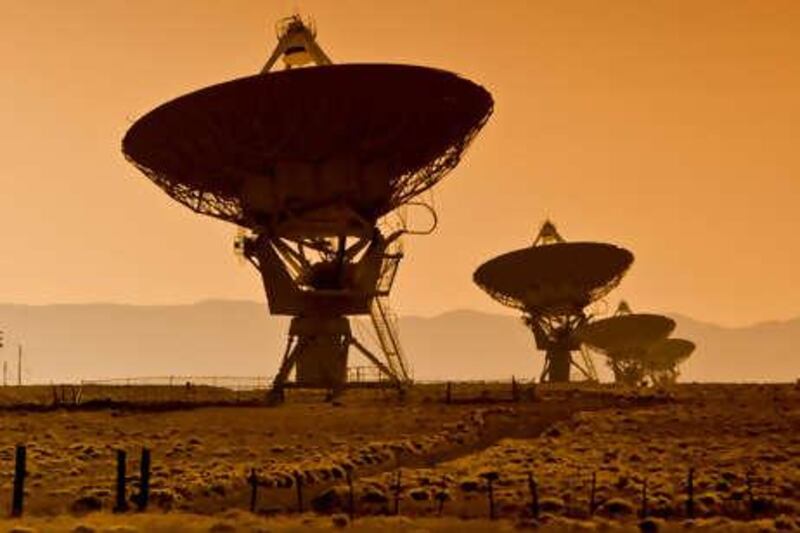Recently, in a quiet and dignified ceremony, I was awarded a certificate by the University of California for my small but vital contribution to the search for extraterrestrial life. Jodie Foster couldn't make it, but I'm sure she would have been proud of me. Well, I say "ceremony". It was more a download of an automatically generated record of my participation since 2007 in SETI@home, the ingenious harnessing of slumbering home computing power in the search for ET - or, at least, for signs of intelligent life in the universe in the form of inbound artificial radio waves.
"This," says the printout, "certifies that Jonathan has participated in the SETI@home project since December 31 2006, and during that time has contributed 4,298 Cobblestones of computation (3.71 quadrillion floating-point operations)." Now, I have no idea what a floating-point operation is, nor any recollection of joining the programme in the first place, but as any regular SETI@homer will recognise, mine has been a particularly poor effort. Since 2007, I have racked up a pathetic 4,235 "cobblestones", or credits. To put my shame properly in context, SETI@home's number-one performer, Nez, an American, has amassed an astronomical 579,769,461.
I stopped searching for aliens when I moved from the UK to the UAE midway through 2008, but last month a plaintive plea popped into my inbox. "Please rejoin SETI@home," it said. "It's been 497 days since you last returned a work unit. We want you back ?" It seemed churlish not to return to the fold. SETI@home, the world's largest and longest-running volunteer computing project, may have 174,000 participants and 280,000 active computers around the world, but it still needs all the help it can get. There is, after all, an awful lot of space to get through. Our own galaxy, the Milky Way, is home to up to 400 billion stars and is merely one of billions of galaxies in the universe; Andromeda, one of our "near" neighbour galaxies, may have a trillion stars. So what are you waiting for?
Volunteers download BOINC, (Berkeley Open Infrastructure for Networking Computing) software, developed by the Space Sciences Laboratory at the University of California, Berkeley, to allow any number of pea-brained home computers to combine via the internet to become one giant supercomputer. Signals are sucked in by the 305-metre dish at the Arecibo Observatory in Puerto Rico, the world's largest and most sensitive radio telescope, operated by Cornell University on behalf of the National Science Foundation (and, along with Foster, the star of the 1997 film Contact). Each computer is sent a burst of about 100 seconds, which can take it anything between 10 and 50 hours to analyse before squirting the results back to Berkeley and receiving another task. Listening for aliens involves zero effort on my part. All the heavy sifting is done by my laptop while it and I sleep; the software operates like a screensaver that is, frankly, many degrees cooler than flying toasters. My Mac is currently processing a burst of data received at Arecibo just after midnight on Thursday, November 30, 2006. Which means that ET could have called four years ago and we still haven't listened to the message.
Not likely, though. Depressingly, more than 99.99 per cent of all signals are generated by earthbound sources of interference, such as radar and TV, so most of the time, my CPU is processing Seinfeld re-runs. (It could be worse. In Contact, the aliens receive Hitler, broadcast from the 1936 Berlin Olympics and still ranting his way across space). Nevertheless, since an equipment upgrade at Arecibo last year - the 10th anniversary of SETI@home - the project is now sucking in signals from seven points in space simultaneously, with even greater sensitivity, increasing "the likelihood that we'll find the first signs of extraterrestrial life. With these new developments comes an increase in required computing power, for which we depend on people like you". Make that "people like us". I have discovered that, while we may well be alone in the universe, I am not alone in the UAE. One can search for aliens as an individual or join a team and SETI has 11 such teams registered in the UAE. That said, several have only one member - which is kind of sad - and the attrition rate appears to be high; only two of the 11 teams are listed as still active: UAE Residents, with 12 members, and Expats@Dubai, with just two. Well three, now I'm on side. Debbie Ponnaiya, from India, has been in the UAE for 18 years and has been listening out for ET with SETI since 1999. Past members of UAE Residents, she says, have included an oil-rig worker and an Emirates pilot. Abductions? Probably not. She thinks they just went home, as many people do from the UAE.
"I am completely non-scientific but I read whatever I can lay my hands on about astrophysics, quantum theory and all of that," says the 54-year-old, a partner in an advertising company, Innovations, based at Sharjah Airport Free Zone. When she read about SETI@home, "I was fascinated." Ponnaiya also writes science fiction as a hobby, which must help; it takes imagination to commit oneself for so long to a project that has had precisely no success, and even whose organisers believe almost certainly never will. There is, she acknowledges, an infinitesimally small chance that SETI@home will hear from ET - and, of course, she stands a better chance of winning a lottery than being the one who gets the call - but she is undeterred. "There is only a vague possibility, but why should that matter? The whole point is to try. It doesn't matter if it is me, or anybody, but the thing is to reach out." Besides, she says, "I love that screensaver." And, indeed, that's where the magic is, the signals from light years away dancing and flickering hypnotically on the screen. "I sit there and watch it sometimes, thinking: 'This might just be it'." If it ever is it, woe betide the volunteer who tweets, blogs, e-mails or otherwise alerts the world. SETI reminds its volunteers that there is a strict, if dusty, protocol to be followed in the remote eventuality of a candidate signal popping up. "It is important that participants do not get excited when they see signals on their screen and go off on their own making announcements and calling the press," SETI says sternly. "This could be very damaging to the project." Nevertheless, like me, Ponnaiya admits to gazing wistfully at the screen, hoping against hope for that Contact moment. Also like me, she wouldn't know a contact if she saw one, but so what? "The computer knows what it's doing," she says. And the man who knows what all the computers are doing is David Anderson, a research scientist at Berkeley's Space Sciences Laboratory who has directed SETI@home since it began in 1999. He also leads the BOINC project, which since its development for SETI has been adopted by many distributive computing projects, from Malariacontrol.net, an exercise in epidemiology by the Swiss Tropical Institute, to Enigma@home, a private cryptography project with the delightfully quixotic objective of cracking three unbroken German Enigma messages intercepted in the North Atlantic in 1942. So even if we never find aliens, it won't have been a complete waste of time. The most inspirational thing about SETI, and especially SETI@home, is what it says about persistent human optimism in the face of almost incalculable odds (and the saddest, perhaps, is what it says about just how badly we don't want to be alone in the universe), but Anderson isn't a big fan of words such as "inspiration" and "optimism". "Those words don't really describe our group," he says. "We don't 'believe' that ET exists, as scientists, and we don't believe anything until we see solid evidence. But we think that the question of whether there's life outside Earth is interesting and important, and that there's a non-zero chance that the answer is yes." A non-zero chance? Only a scientist could sound so negative about a potential positive. In The Eerie Silence, a book published this year to mark SETI's golden anniversary, the author Paul Davies, a physicist and astrobiologist who chairs SETI's Post-Detection Taskgroup, reveals that, as a scientist, he believes flat-out that we are alone in the universe. Now, this is the man charged with planning ET's welcome party - who to invite, how we are going to react, when to break the news to Spielberg - and even he doesn't believe ET will ever call? Yet still he's ready to string the bunting and pump up the balloons and, quite literally, his group keeps champagne permanently on ice. Science aside, as a human being, says Davies, "I can think of no more thrilling a discovery than coming across clear evidence for extraterrestrial intelligence." It was the search for that thrill that on the night of April 8, 1960, prompted Frank Drake, a young astronomer at the US National Radio Astronomy Observatory in West Virginia, to point its 26-metre dish in the direction of Tau Ceti, a Sun-like star 11 light years distant and a candidate to host an unseen planet or two. Nothing. Next, he turned the dish towards a neighbouring star, Epsilon Eridani. Almost immediately, he picked up what seemed to be an artificial signal. Davies describes the moment in his book: "Suddenly, a series of dramatic booms emanated from the loudspeaker and the pen recorder began frantically flying back and forth. Drake almost fell off his chair." This was the magic moment that kickstarted the SETI project and inspired the astronomer Carl Sagan to write the 1985 novel Contact, on which the film is based. In fiction, the signal is for real - a series of prime numbers unmistakably from an intelligent extraterrestrial source. In real life, however, Drake's signal turned out to be from a nearby secret military radar. Since then, to be honest, there hasn't been much falling off chairs at SETI. In fact, it was August 15, 1977, before anyone next felt even the faintest urge to shift in his seat. An astronomer browsing through a printout of data from Ohio State University's Big Ear telescope spotted what appeared to be a 72-second artificial signal. He circled the numbers, wrote "Wow!" in the margin, and the legend of the Wow! signal, a mystery that remains unresolved, was born. Since its launch in May 1999, SETI@home has had only one close encounter of the heard kind to call its own. In February 2003, two separate computers, continents apart and spending their down-time slowly chewing their way through SETI@home data, just like mine, isolated the same peculiar signal, designated Radio Source SHGb02+14a. In SETI terms, this was a "Gaussian candidate", also known as Big News. Because the Arecibo dish is fixed, the movement of the Earth means it tracks across any possible artificial radio source in space; as it does, over a period of about 12 seconds the signal will grow stronger, peak, and then weaken again, forming a classic Gaussian, or bell curve. In September 2004, New Scientist broke the story of the "Mysterious signals from light years away", originating from somewhere between the constellations Pisces and Aries. When SETI protocols kicked in and the signal was confirmed by a third party, reported the magazine, this was "the best candidate yet for a contact by intelligent aliens in the ? history of the SETI@home project". SETI@home, however, played down the finding and that was that. "The scoring function used to rank candidates was a bit primitive in 2004, it omitted some important factors," says Anderson. "When we took into account the missing factors it was no longer interesting." There are doubters who question SETI's methodology. Davies, for one, poses some uncomfortable questions in a book littered with many puzzles but few answers. "Fifty years of silence," he says, "is an excellent cue for us to enlarge our thinking about the subject" and to "free SETI from the shackles of anthropocentrism". Maybe, he ponders, microbial aliens are all around us - or even in us. And why assume aliens are sending out radio waves just because, since the invention of radio and television signalling on Earth, we are? If we stick with the radio signals, how do we know where to look? Monitoring every possible frequency would be impossible and so, based on an intelligent guess, the search was and remains limited to a narrow bandwidth around 1,420 megahertz. This is assumed to be the frequency aliens are most likely to use because it is the one at which hydrogen, the most common element in the universe, resonates and, accordingly, by international agreement it is kept clear of earthbound transmissions. But if the call is coming in on 1,419 megahertz, say, we are going to miss it. None of which alters the fact that it could be me who first hears from ET, and that I could get the call tomorrow. But then what? Will I win an intergalactic prize, or will I be the first to be raygunned by the little green men? After all, in the Hollywood history of alien contact, being the first to encounter extraterrestrials has rarely played out well. Either way, I figure it's worth the risk. As Jodie Foster's dad says: "If it really is just us, it seems like an awful waste of space." Become a volunteer at setiathome.berkeley.edu. The Eerie Silence - Are We Alone in the Universe? is published by Allen Lane at Dh130.





